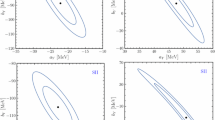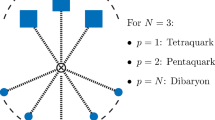Abstract
Based on an assumed mass formula for the spectrum of the Y=2 pentaquarks, where the chromo-magnetic interaction plays an important role, and identifying the lightest state with the Θ+(1540), we predict a spectrum in good agreement with the few I=0 and I=1 candidates proposed in the past.
Similar content being viewed by others
References
Photon Nucleus T. Nakano et al. (LEPS Collaboration): “Observation of S=+1 baryon resonance in photo-production from neutron”, Phys. Rev. Lett., Vol. 91, (2003), pp. 012002.
Kaon Nucleus V.V. Barmin et al. (DIANA Collaboration): “Observation of a baryon resonance with positive strangeness in K+ collisions with Xe nuclei”, Phys. Atom. Nucl., Vol. 66, (2003), pp. 1715–1718;Yad. Fiz., Vol. 66, (2003), 1763.
Photon Deuteron S. Stepanyan et al. (CLAS Collaboration): “Observation of an exotic S=+1 baryon in exclusive photoproduction from the deuteron”, Phys. Rev. Lett., Vol. 91, (2003), pp. 252001.
Photon Proton J. Barth et al. (SAPHIR Collaboration): “Observation of the positive-strangeness pentaquark Theta+ in photoproduction with the SAPHIR detector at ELSA”, Phys. Lett. B, Vol. 572, (2003), pp. 127–132;
V. Kubarovsky and S. Stepanyan (CLAS Collaboration): “Evidence for an exotic baryon state, Theta (1540)+, in photoproduction reactions from protons and deuterons with CLAS”, AIP Conf. Proc., Vol. 698, (2004), pp. 543–547.
Neutrino (D+Ne) A.E. Asratyan, A.G. Dolgolenko and M.A. Kubantsev: “Evidence for formation of a narrow K0(S) p resonance with mass near 1533-MeV in neutrino interactions”, Phys. Atom. Nucl., Vol. 67, (2004), pp. 682–687;Yad. Fiz., Vol. 67, (2004), pp. 704–709; A. Airapetian et al. (HERMES Collaboration): “Evidence for a narrow |S|=1 baryon state at a mass of 1528-MeV in quasi-real photoproduction”, Phys. Lett. B, Vol. 585, (2004), pp. 213–222.
D. Diakonov, V. Petrov and M.V. Polyakov: “Exotic anti-decuplet of baryons: Prediction from chiral solitons”, Z. Phys. A, Vol. 359, (1997), pp. 305–314; H. Weigel: “Radial excitations of low-lying baryons and the Z+ penta-quark”, Eur. Phys. J. A., Vol. 2, (1998), pp. 391–402.
T.H.R. Skyrme: “A Unified Field Theory Of Mesons And Baryons”, Nucl. Phys., Vol. 31, (1962), pp. 556–569; E. Witten: “Current Algebra, Baryons, And Quark Confinement”, Nucl. Phys. B, Vol. 223, (1983), pp. 433–444; G.S. Adkins, C.R. Nappi and E. Witten: “Static Properties Of Nucleons In The Skyrme Model”, Nucl. Phys. B, Vol. 228, (1983), pp. 552–566; E. Guadagnini: “Baryons As Solitons And Mass Formulae”, Nucl. Phys. B, Vol. 236, (1984), pp. 35–47; M. Chemtob: “Skyrme Model Of Baryon Octet And Decuplet”, Nucl. Phys. B, Vol. 256, (1985), pp. 600–608.
F. Stancu and D.O. Riska: “Stable u u d d anti-s pentaquarks in the constituent quark model”, Phys. Lett. B, Vol. 575, (2003), pp. 242–248.
R.L. Jaffe and F. Wilczek: “Diquarks and exotic spectroscopy”, Phys. Rev. Lett., Vol. 91, (2003), pp. 232003.
B.K. Jennings and K. Maltman: “Z* resonances: Phenomenology and models”, Phys. Rev. D, Vol. 69, (2004), pp. 094020.
R. Bijker, M.M. Giannini and E. Santopinto: “Spectroscopy of pentaquark states”, Eur. Phys. J. A, Vol. 22, (2004), pp. 319–329.
C.E. Carlson, C.D. Carone, H.J. Kwee and V. Nazaryan: “Phenomenology of the pentaquark antidecuplet”, Phys. Lett. B, Vol. 573, (2003), pp. 101–108.
F. Buccella and P. Sorba: “Narrow width pentaquarks”, Mod. Phys. Lett. A, Vol. 19, (2004), pp. 1547–1559.
J.J. Dudek and F.E. Close: “The J=3/2 Theta* partner to the Theta(1540) baryon”, Phys. Lett. B, Vol 583, (2004), pp. 278–284.
J.J. Dudek: “A model realisation of the Jaffe-Wilczek correlation for pentaquarks”, arXiv:hep-ph/0403235.
H. Hogaasen, and P. Sorba: “The colour triplet q q anti-q cluster and pentaquark models”, Mod. Phys. Lett. A, Vol. 19, (2004), pp. 2403–2410.
I.M. Narodetskii, C. Semay, B. Silvestre-Brac and Y.A. Simonov: “Pentaquarks in the string dynamics”, Nucl. Phys. Proc. Suppl., Vol. 142, (2005), pp. 383–387.
H. Hogaasen and P. Sorba: “The Systematics of Possibly Narrow Quark States With Baryon Number One”, Nucl. Phys. B, Vol. 145, (1978), pp. 119–140; M. de Crombrugghe, H. Hogaasen and P. Sorba: “Quantitative Predictions For 4 Q Anti-Q Baryons”, Nucl. Phys. B, Vol. 156, (1979), pp. 347–364.
A. de Rujula, H. Georgi and S.L. Glashow: “Hadron Masses In A Gauge Theory”, Phys. Rev. D, Vol. 12, (1975), pp. 147–162.
R.A. Arndt and L.D. Roper: “K+ Proton Partial Wave Analysis to 3-Gev/C”, Phys. Rev. D, Vol. 31, (1985), pp. 2230–2241.
M. Roos et al.: “Review Of Particle Properties. Particle Data Group”, Phys. Lett. B, Vol. 111, (1982), pp. 1–294.
J.S. Hyslop, R.A. Arndt, L.D. Roper and R.L. Workman: “Partial wave analysis of K+ nucleon scattering”, Phys. Rev. D, Vol. 46, (1992), pp. 961–969.
F. Gursey and L.A. Radicati: “Spin and unitary spin independence of strong interactions”, Phys. Rev. Lett., Vol. 13, (1964), pp. 173–175.
F. Buccella: “A selection rule for multiquark decays”, arXiv:hep-ph/0411244.
C.E. Carlson, C.D. Carone, H.J. Kwee and V. Nazaryan: “A naturally narrow positive parity Theta+”, Phys. Rev. D, Vol. 70, (2004), pp. 037501.
G.C. Rossi and G. Veneziano: “Electromagnetic Mixing Of Narrow Baryonium States”, Phys. Lett. B, Vol. 70, (1977), pp. 255–259; G.C. Rossi and G. Veneziano: “Isospin mixing of narrow pentaquark states”, Phys. Lett. B, Vol. 597, (2004), pp. 338–345.
R.L. Jaffe: “Q**2 Anti-Q**2 Resonances In The Baryon—Anti-Baryon System”, Phys. Rev. D, Vol. 17, (1978), pp. 1444–1458.
A. Alosio et al., (KLOE Collaboration): “Study of the decay Phi→pi0 pi0 gamma with the KLOE detector”, Phys. Lett. B, Vol. 537, (2002), pp. 21–27; E.M. Aitala et al. (E791 Collaboration): “Experimental evidence for a light and broad scalar resonance in D+→pi−pi+pi+ decay”, Phys. Rev. Lett., Vol. 86, (2001), pp. 770–774.
C. Alt et al. (NA49 Collaboration): “Observation of an exotic S=−2, Q=−2, baryon resonance in proton proton collisions at the CERN SPS”, Phys. Rev. Lett., Vol. 92, (2004), pp. 042003.
Author information
Authors and Affiliations
About this article
Cite this article
Buccella, F., Falcone, D. & Tramontano, F. Spectrum of the Y=2 pentaquarks. centr.eur.j.phys. 3, 525–535 (2005). https://doi.org/10.2478/BF02475610
Received:
Accepted:
Issue Date:
DOI: https://doi.org/10.2478/BF02475610




